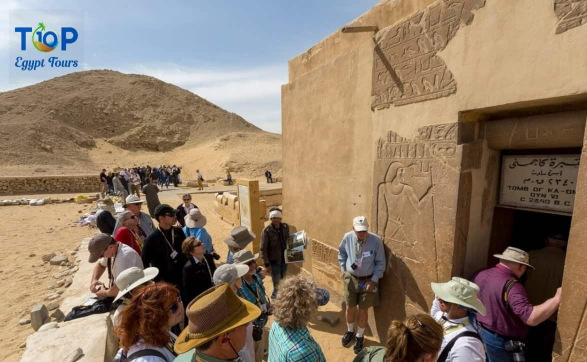The Mastaba Tomb of Kagemni, also known as the Tomb of Kagemni, is an ancient Egyptian tomb located in the Saqqara necropolis, about 30 kilometers south of Cairo. The mastaba was built for Kagemni, a high-ranking official during the reign of King Teti of the 6th Dynasty (2345-2323 BC).
The Mastaba Tomb of Kagemni is one of the largest and most well-preserved mastabas in Saqqara. The tomb is decorated with several reliefs and inscriptions that depict Kagemni’s life and career. The tomb also has many chambers and passageways that visitors can explore.
In this article, we will uncover for you the Mastaba Tomb of Kagemni with Top Ten Egypt.
The Mastaba Tomb of Kagemni: A Testament to Ancient Egyptian Architecture
The Mastaba Tomb of Kagemni is a classic example of ancient Egyptian mastaba architecture. Mastabas were rectangular tombs with flat roofs that were built for high-ranking officials and members of the royal family.
The Mastaba Tomb of Kagemni is made of limestone and mudbrick. The exterior of the tomb is decorated with many reliefs and inscriptions that depict Kagemni’s life and career. The interior of the tomb has some chambers and passageways, including a chapel, a burial chamber, and some storage chambers.
The tomb’s chapel is decorated with many reliefs and inscriptions that show Kagemni making offerings to the gods. The burial chamber is where Kagemni’s sarcophagus was placed. The storage chambers were used to store Kagemni’s personal belongings and funerary goods.
Historical Context: The 6th Dynasty
Kagemni was a high-ranking official during the reign of King Teti of the 6th Dynasty. He served as the Chief Justice and Vizier of Egypt, which was the highest position in the government at the time. Kagemni was also the overseer of all the pharaoh’s works and the overseer of six great courts.
The 6th Dynasty was a period of peace and prosperity in Egypt. The pharaohs of the 6th Dynasty were great builders, and they constructed several pyramids and temples throughout Egypt. Kagemni played an important role in the construction of the pyramids of King Teti and King Pepi I.
Function and Importance: A Final Resting Place for a High-Ranking Official
It served as his final resting place. The tomb was built to ensure Kagemni’s safe passage to the afterlife. The reliefs and inscriptions in the tomb were intended to help Kagemni navigate the afterlife and to provide him with all that he needed in the next world.
The tomb is also a testament to Kagemni’s wealth and status. The size and complexity of the tomb reflect Kagemni’s importance in Egyptian society. The tomb’s reliefs and inscriptions also provide insights into Kagemni’s life and career.
Architectural Features: A Blend of Reliefs and Inscriptions
The Mastaba Tomb of Kagemni is decorated with some reliefs and inscriptions. The reliefs depict Kagemni’s life and career, including his duties as Chief Justice and Vizier. The inscriptions provide information about Kagemni’s family and titles.
The reliefs and inscriptions in the tomb are carved into the limestone walls. The reliefs are painted in a variety of colors, including red, yellow, blue, and black. The inscriptions are written in hieroglyphs, which is the ancient Egyptian writing system.
Preservation and Restoration Efforts: Protecting a Historical Gem
The Mastaba Tomb of Kagemni has undergone extensive preservation and restoration work to protect its historical value. Archaeological excavations have been conducted to uncover the tomb’s hidden features and to learn more about its history. Structural repairs have also been carried out to stabilize the tomb and to prevent further deterioration.
It is now open to the public, and it is one of the most popular tourist attractions in Saqqara. Visitors can explore the tomb’s chambers and passageways, and they can admire the reliefs and inscriptions that decorate the walls.
Conclusion
The Mastaba Tomb of Kagemni is a fascinating and important ancient Egyptian site. It is a testament to the ancient Egyptians’ skill in architecture, art, and engineering. The tomb also provides insights into the life and career of a high-ranking official during the 6th Dynasty.
Browse our complete list of Egypt tours Click Here



Comment (0)